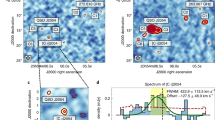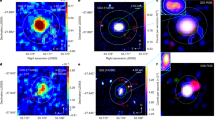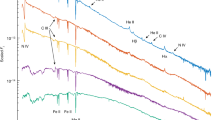Abstract
The physical conditions of the circumgalactic medium are investigated by means of intervening absorption-line systems in the spectrum of background quasi-stellar objects (QSOs) out to the epoch of cosmic reionization1,2,3,4. A correlation between the ionization state of the absorbing gas and the nature of the nearby galaxies has been suggested by the sources detected in either Lyα or [C ii] 158 μm near to, respectively, highly ionized and neutral absorbers5,6. This is also probably linked to the global changes in the incidence of absorption systems of different types and the process of cosmic reionization7,8,9,10,11,12. Here we report the detection of two [C ii]-emitting galaxies at redshift z ≈ 5.7 that are associated with a complex, high-ionization C iv absorption system. These objects are part of an overdensity of galaxies and have compact sizes (<2.4 kpc) and narrow linewidths (full width at half maximum (FWHM) ≈ 62–64 km s−1). Hydrodynamic simulations predict that similar narrow [C ii] emission may arise from the heating of small (≲3 kpc) clumps of cold neutral medium or a compact photodissociation region13,14. The lack of counterparts in the rest-frame ultraviolet (UV) indicates severe obscuration of the sources that are exciting the [C ii] emission. These results may suggest a connection between the properties of the [C ii] emission, the rare overdensity of galaxies and the unusual high ionization state of the gas in this region.
This is a preview of subscription content, access via your institution
Access options
Access Nature and 54 other Nature Portfolio journals
Get Nature+, our best-value online-access subscription
$29.99 / 30 days
cancel any time
Subscribe to this journal
Receive 51 print issues and online access
$199.00 per year
only $3.90 per issue
Buy this article
- Purchase on Springer Link
- Instant access to full article PDF
Prices may be subject to local taxes which are calculated during checkout


Similar content being viewed by others
Data availability
The ALMA, HST and VLT datasets used in this work are publicly available, respectively, through the ALMA data archive at https://almascience.nao.ac.jp/aq/ (project code 2017.1.00621.S), the HST data archive at https://archive.stsci.edu/missions-and-data/hst (proposal IDs 9777, 13303 and 15085) and the European Southern Observatory Science Archive at http://archive.eso.org (programme IDs 084.A-0360, 086.A-0162, 086.A-0574, 087.A-0607 and 095.A-0714).
Code availability
The ALMA data were processed using the CASA pipeline version 5.4, which is available at https://casa.nrao.edu. The interferopy package that includes the findclumps source finding program is available at https://github.com/interferopy/interferopy. The VLT/XShooter spectral data were reduced using the PypeIt package available at https://github.com/pypeit/PypeIt. The Magellan FIRE spectral data were reduced using the FIREHOSE pipeline available at https://wikis.mit.edu/confluence/display/FIRE/FIRE+Data+Reduction and corrected using the xtellcor package available at http://irtfweb.ifa.hawaii.edu/~spex/index.html. The DrizzlePac software used for the HST data reduction is available at https://www.stsci.edu/scientific-community/software/drizzlepac.html. The reduction pipelines of the VLT instruments are available at https://www.eso.org/sci/software/pipelines/.
References
Simcoe, R. A., Sargent, W. L. W., Rauch, M. & Becker, G. Observations of chemically enriched QSO absorbers near z~2.3 galaxies: galaxy formation feedback signatures in the intergalactic medium. Astrophys. J. 637, 648–668 (2006).
Prochaska, J. X. et al. The UCSD/Keck damped Lyα abundance database: a decade of high-resolution spectroscopy. Astrophys. J. Suppl. Ser. 171, 29–60 (2007).
Fox, A. J., Ledoux, C., Petitjean, P. & Srianand, R. C IV absorption in damped and sub-damped Lyman-α systems. Correlations with metallicity and implications for galactic winds at z ≈ 2–3. Astron. Astrophys. 473, 791–803 (2007).
Bordoloi, R. et al. Resolving the H I in damped Lyman α systems that power star formation. Nature 606, 59–63 (2022).
Díaz, C. G. et al. Faint LAEs near z > 4.7 C IV absorbers revealed by MUSE. Mon. Not. R. Astron. Soc. 502, 2645–2663 (2021).
Wu, Y. et al. A [C II] 158 μm emitter associated with an O I absorber at the end of the reionization epoch. Nat. Astron. 5, 1110–1117 (2021).
Becker, G. D., Sargent, W. L. W., Rauch, M. & Simcoe, R. A. Discovery of excess O I absorption toward the z = 6.42 QSO SDSS J1148+5251. Astrophys. J. 640, 69–80 (2006).
Simcoe, R. A. et al. Constraints on the universal C IV mass density at z ~ 6 from early infrared spectra obtained with the Magellan FIRE spectrograph. Astrophys. J. 743, 21 (2011).
Chen, S.-F. S. et al. Mg II absorption at 2 < z < 7 with Magellan/Fire. III. Full statistics of absorption toward 100 high-redshift QSOs. Astrophys. J. 850, 188 (2017).
Codoreanu, A. et al. The CGM and IGM at z ~ 5: metal budget and physical connection. Mon. Not. R. Astron. Soc. 481, 4940–4959 (2018).
Cooper, T. J. et al. Heavy element absorption systems at 5.0 < z < 6.8: metal-poor neutral gas and a diminishing signature of highly ionized circumgalactic matter. Astrophys. J. 882, 77 (2019).
Becker, G. D. et al. The evolution of O I over 3.2 < z < 6.5: reionization of the circumgalactic medium. Astrophys. J. 883, 163 (2019).
Vallini, L., Gallerani, S., Ferrara, A. & Baek, S. Far-infrared line emission from high-redshift galaxies. Mon. Not. R. Astron. Soc. 433, 1567–1572 (2013).
Vallini, L., Gallerani, S., Ferrara, A., Pallottini, A. & Yue, B. On the [CII]-SFR relation in high redshift galaxies. Astrophys. J. 813, 36 (2015).
Dutta, R. et al. Metal-enriched halo gas across galaxy overdensities over the last 10 billion years. Mon. Not. R. Astron. Soc. 508, 4573–4599 (2021).
Toshikawa, J. et al. Discovery of protoclusters at z ~ 3.7 and 4.9: embedded in primordial superclusters. Astrophys. J. 888, 89 (2020).
Venemans, B. P. et al. Kiloparsec-scale ALMA imaging of [C II] and dust continuum emission of 27 quasar host galaxies at z ~ 6. Astrophys. J. 904, 130 (2020).
Zana, T. et al. Enhanced star formation in z ~ 6 quasar companions. Mon. Not. R. Astron. Soc. 513, 2118–2135 (2022).
Aravena, M. et al. The ALMA Spectroscopic Survey in the Hubble Ultra Deep Field: search for [C II] line and dust emission in 6 < z < 8 galaxies. Astrophys. J. 833, 71 (2016).
Neeleman, M. et al. [C II] 158-μm emission from the host galaxies of damped Lyman-alpha systems. Science 355, 1285–1288 (2017).
Fujimoto, S. et al. The ALPINE–ALMA [C II] survey: size of individual star-forming galaxies at z = 4–6 and their extended halo structure. Astrophys. J. 900, 1 (2020).
Fudamoto, Y. et al. The ALMA REBELS survey: average [C II] 158 μm sizes of star-forming galaxies from z ~ 7 to z ~ 4. Astrophys. J. 934, 144 (2022).
Olsen, K. P. et al. Simulator of Galaxy Millimeter/Submillimeter Emission (SíGAME): The [C II]-SFR relationship of massive z = 2 main sequence galaxies. Astrophys. J. 814, 76 (2015).
De Looze, I. et al. The applicability of far-infrared fine-structure lines as star formation rate tracers over wide ranges of metallicities and galaxy types. Astron. Astrophys. 568, A62 (2014).
Schaerer, D. et al. The ALPINE-ALMA [C II] survey. Little to no evolution in the [C II]-SFR relation over the last 13 Gyr. Astron. Astrophys. 643, A3 (2020).
Carniani, S. et al. Kiloparsec-scale gaseous clumps and star formation at z = 5–7. Mon. Not. R. Astron. Soc. 478, 1170–1184 (2018).
Le Fèvre, O. et al. The ALPINE-ALMA [CII] survey. Survey strategy, observations, and sample properties of 118 star-forming galaxies at 4 < z < 6. Astron. Astrophys. 643, A1 (2020).
Fudamoto, Y. et al. The ALPINE-ALMA [CII] survey. Dust attenuation properties and obscured star formation at z ~ 4.4–5.8. Astron. Astrophys. 643, A4 (2020).
Pentericci, L. et al. Tracing the reionization epoch with ALMA: [C II] emission in z ~ 7 galaxies. Astrophys. J. Lett. 829, L11 (2016).
Bradač, M. et al. ALMA [C II] 158 μm detection of a redshift 7 lensed galaxy behind RX J1347.1–1145. Astrophys. J. Lett. 836, L2 (2017).
Behrens, C., Pallottini, A., Ferrara, A., Gallerani, S. & Vallini, L. Dusty galaxies in the Epoch of Reionization: simulations. Mon. Not. R. Astron. Soc. 477, 552–565 (2018).
Planck Collaboration et al. Planck 2018 results. VI. Cosmological parameters. Astron. Astrophys. 641, A6 (2020).
Alam, S. et al. The eleventh and twelfth data releases of the Sloan Digital Sky Survey: final data from SDSS-III. Astrophys. J. Supp. 219, 12 (2015).
McMullin, J. P., Waters, B., Schiebel, D., Young, W. & Golap, K. in Astronomical Data Analysis Software and Systems XVI ASP Conference Series Vol. 376 (eds Shaw, R. A., Hill, F. & Bell, D. J.) 127 (Astronomical Society of the Pacific, 2007).
Walter, F. et al. ALMA spectroscopic survey in the Hubble Ultra Deep Field: survey description. Astrophys. J. 833, 67 (2016).
Boogaard, L., Meyer, R. A. & Novak, M. Interferopy: analysing datacubes from radio-to-submm observations. Zenodo https://zenodo.org/record/5775604 (2021).
Popping, G. et al. Sub-mm emission line deep fields: CO and [C II] luminosity functions out to z = 6. Mon. Not. R. Astron. Soc. 461, 93–110 (2016).
Ferrara, A. et al. The ALMA REBELS Survey. Epoch of Reionization giants: properties of dusty galaxies at z ≈ 7. Mon. Not. R. Astron. Soc. 512, 58–72 (2022).
Béthermin, M. et al. The ALPINE-ALMA [CII] survey: data processing, catalogs, and statistical source properties. Astron. Astrophys. 643, A2 (2020).
Madau, P. & Dickinson, M. Cosmic star-formation history. Annu. Rev. Astron. Astrophys. 52, 415–486 (2014).
Chabrier, G. Galactic stellar and substellar initial mass function. Publ. Astron. Soc. Pac. 115, 763–795 (2003).
Vernet, J. et al. X-shooter, the new wide band intermediate resolution spectrograph at the ESO Very Large Telescope. Astron. Astrophys. 536, A105 (2011).
Simcoe, R. A. et al. FIRE: a facility class near-infrared echelle spectrometer for the Magellan telescopes. Publ. Astron. Soc. Pac. 125, 270 (2013).
Prochaska, J. et al. PypeIt: the Python spectroscopic data reduction pipeline. J. Open Source Softw. 5, 2308 (2020).
Gagné, J., Lambrides, E., Faherty, J. K. & Simcoe, R. FireHose_v2: Firehose v2.0. Zenodo https://zenodo.org/record/18775 (2015).
Vacca, W. D., Cushing, M. C. & Rayner, J. T. A method of correcting near-infrared spectra for telluric absorption. Publ. Astron. Soc. Pac. 115, 389–409 (2003).
Cushing, M. C., Vacca, W. D. & Rayner, J. T. Spextool: a spectral extraction package for SpeX, a 0.8–5.5 micron cross-dispersed spectrograph. Publ. Astron. Soc. Pac. 116, 362–376 (2004).
Foreman-Mackey, D., Hogg, D. W., Lang, D. & Goodman, J. emcee: the MCMC hammer. Publ. Astron. Soc. Pac. 125, 306–312 (2013).
Hoffmann, S. L. et al. The DrizzlePac Handbook, Version 2.0. Space Telescope Science Institute https://hst-docs.stsci.edu/drizzpac (2021).
Weilbacher, P. M. et al. The data processing pipeline for the MUSE instrument. Astron. Astrophys. 641, A28 (2020).
Borisova, E. et al. Ubiquitous giant Lyα nebulae around the brightest quasars at z ~ 3.5 revealed with MUSE. Astrophys. J. 831, 39 (2016).
Cantalupo, S. et al. The large- and small-scale properties of the intergalactic gas in the Slug Ly α nebula revealed by MUSE He II emission observations. Mon. Not. R. Astron. Soc. 483, 5188–5204 (2019).
Bacon, R. et al. The MUSE 3D view of the Hubble Deep Field South. Astron. Astrophys. 575, A75 (2015).
Acknowledgements
This work is based on the ALMA observation under ADS/JAO.ALMA#2011.0.01234.S. ALMA is a partnership of the ESO (representing its member states), NSF (USA) and NINS (Japan), together with NRC (Canada), MOST and ASIAA (Taiwan) and KASI (Republic of Korea), in cooperation with the Republic of Chile. The Joint ALMA Observatory is operated by the ESO, AUI/NRAO and NAOJ. This research makes use of observations made with the NASA/ESA HST obtained from the Space Telescope Science Institute, which is operated by the Association of Universities for Research in Astronomy, Inc., under NASA contract NAS 5-26555. This paper includes data gathered with the 6.5-m Magellan telescopes located at Las Campanas Observatory, Chile. Data analysis was in part carried out on the Multi-wavelength Data Analysis System operated by the Astronomy Data Center, NAOJ. We acknowledge support from JSPS KAKENHI grant number JP21K13956.
Author information
Authors and Affiliations
Contributions
D.K., S.J.L., R.B. and R.A.S. discussed and planned the ALMA programme and the HST observations in the F775W band. R.A.S. obtained the HST observation in the F160W band. A.-C.E. and R.A.S. analysed the XShooter and FIRE spectroscopic data of QSO J1030+0524. R.M. reduced and calibrated the MUSE data. S.J.L., J.M., R.A.S., R.M. and A.-C.E. contributed to the discussion of the presented results and the preparation of the manuscript. D.K. led the team, being principal investigator of the ALMA programme, analysed the ALMA and ancillary data, wrote the main text and the Methods section, and produced all figures and the table in the article.
Corresponding author
Ethics declarations
Competing interests
The authors declare no competing interests.
Peer review
Peer review information
Nature thanks the anonymous reviewers for their contribution to the peer review of this work.
Additional information
Publisher’s note Springer Nature remains neutral with regard to jurisdictional claims in published maps and institutional affiliations.
Extended data figures and tables
Extended Data Fig. 1 Antenna response (primary beam) map of the mosaic ALMA observation.
The response is normalized to one at the field centre and the survey field is defined as the area of about 23″ in radius at which the relative response is above 20%. The primary beam size of the seven individual pointings (r = 15″) that compose the mosaic observation is shown by the dotted-line circles with pointing numbers from 1 to 7. The positions of the two [C ii] sources ([C ii]1030A and B) are marked by red stars.
Extended Data Fig. 2 Fidelity in our line search.
Upper panels, number of positive (blue) and negative (that is, noise; red) peaks detected in the four ALMA datacubes (one column for each). The frequency range of each SPW is denoted at the top. Lower panels, the fidelity at given S/N with the model fit as an error function (solid red line).
Extended Data Fig. 3 Reliability check of the [C ii] detection.
For each of [C ii]1030A (left) and B (right), the spectra and the [C ii] moment-0 maps (2″ × 2″) constructed in the reliability tests are compared with those from the full dataset that are shown in the top row. The second and third rows show the results under only XX or YY polarization. The fourth and fifth rows show the results for the first and second half exposure time intervals. The sixth and seventh rows show the results from processing each of the two individual ALMA pointings that cover the source position. In the spectral plots, the collapsed channel window is shown by dotted vertical lines. In the [C ii] intensity maps, the solid (dashed) contours mark positive (negative) steps of 1σ root mean square starting at 2σ (−2σ). All of these products from the partial dataset exhibit substantial signals that coincide both spatially and spectrally to those seen in the full dataset.
Extended Data Fig. 4 Continuum maps.
Each image cuts out the 3″ × 3″ region centred at the position of [C ii]1030A (left panel) and B (right panel). The rest-frame 1,900 GHz continuum intensity is shown by the colour scale. The synthesized continuum beam size is indicated by the white circle in the lower-left corner.
Extended Data Fig. 5 C iv and Si iv absorption systems at zabs ≈ 5.7.
Each panel corresponds to the transition labelled at the upper left. The black line shows the observed spectrum of QSO J1030+0524, whereas the light-brown line denotes the standard deviation of the flux. The blue lines indicate 50 random Voigt profiles sampled from the posterior distribution. The origin of the velocity scale was chosen to correspond to the strongest absorption system at zabs = 5.7246, which is marked along with the two other systems (zabs = 5.7411 and 5.7443) with the dashed blue lines. The vertical red lines indicate the relative velocities of [C ii]1030A and B.
Extended Data Fig. 6 HST broadband images.
Each image cuts out the 3″ × 3″ region centred at the position of [C ii]1030A (upper row) and B (lower row). From left to right, these images are F775W, F850LP and F160W, respectively, which sample the rest-frame 1,150 Å, 1,350 Å and 2,300 Å. No notable rest-frame UV counterpart is detected at the positions of the [C ii] emission.
Rights and permissions
Springer Nature or its licensor (e.g. a society or other partner) holds exclusive rights to this article under a publishing agreement with the author(s) or other rightsholder(s); author self-archiving of the accepted manuscript version of this article is solely governed by the terms of such publishing agreement and applicable law.
About this article
Cite this article
Kashino, D., Lilly, S.J., Simcoe, R.A. et al. Compact [C ii] emitters around a C iv absorption complex at redshift 5.7. Nature 617, 261–264 (2023). https://doi.org/10.1038/s41586-023-05901-3
Received:
Accepted:
Published:
Issue Date:
DOI: https://doi.org/10.1038/s41586-023-05901-3
Comments
By submitting a comment you agree to abide by our Terms and Community Guidelines. If you find something abusive or that does not comply with our terms or guidelines please flag it as inappropriate.



